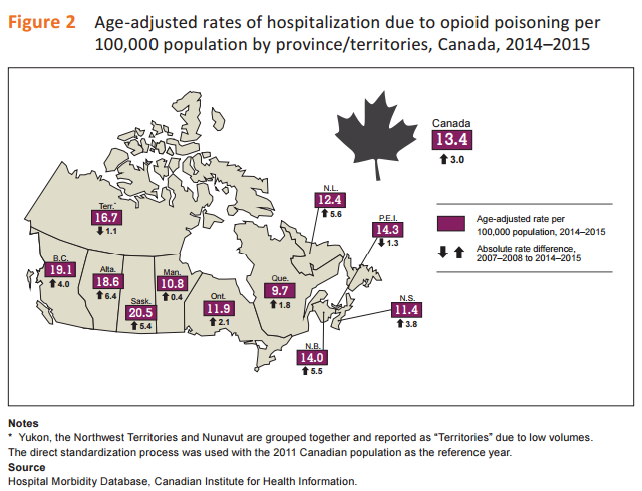The highest rate of hospitalizations from opioid poisonings is in Saskatchewan, according to a new report.

The joint report by the Canadian Institute for Health Information (CIHI) and the Canadian Centre on Substance Abuse found that from 2014-15, there were 20.5 hospitalizations due to opioid poisoning per 100,000 population, the highest across all the provinces and territories in Canada.
Across Canada, there was an average of 13 hospitalizations per day.

Faye Tomlinson said she is surprised by the numbers.
“It just seemed high in the fact that so many were opioid hospitalizations that I thought it would be somewhat on part with the other provinces when they’re lower,” Tomlinson said.
“It made me wonder why it was so high. Are we doing something different in the community, are we not aggressive enough in the community, in public education, in transport to the hospital? Do we wait to get to the hospital before anything is done.”
Her son, Stefan, died of a fentanyl overdose last year at age 25 after struggling with addiction.
Stefan’s sister, Joelle, a reporter at Global News Saskatoon, opened up about the family’s story last year.
READ MORE: Global News reporter shares heartbreaking story about losing brother to fentanyl
Tomlinson said it’s important to look at what other provinces are doing in terms of education and other ways to deal with the problem.
“I think the attitude that what happens in the bigger centres doesn’t happen here and that our numbers aren’t that bad.”
However, emergency department visits due to opioid poisoning were only examined in Ontario and Alberta in the report as the two provinces had comprehensive data available.
READ MORE: Opioid-related emergency room visits 57% higher in Alberta than Ontario: report
Tomlinson has had experience navigating hospitalization for opioids both with her son and working in an emergency room.
She said it wasn’t easy. Stefan ended up in the emergency room twice, once with friends taking him and then another with family due to a psychosis.
“You feel kind of green because when you have a physical ailment you go to a family doctor and our family doctor was exceptional in trying to co-ordinate care but my biggest roadblock was waiting to see a psychiatrist,” Tomlinson said.
“That took months, approximately six months to get in.”
Tomlinson said they had an opportunity through emergency to see a psychiatrist sooner but Stefan missed an appointment and they had to go to the family doctor to see another again.
“I don’t know if there should be a little more streamlining or sort of a clinic where anybody can go and they direct you down these pathways and offer counselling to families and that too.”
Tomlinson said the report is necessary for the public to understand what is happening across Saskatchewan.
“I think it gives you more data to say, hey look, should we be looking at other centres to see what we can do to decrease these numbers?”
Kathy Willerth, director of mental health and addiction with the Ministry of Health in Saskatchewan, said the numbers from the report were also a surprise a ministry.
“Although we certainly would recognize that the situation of opioids or opioid misuse is an issue in all jurisdictions in our province and in Canada, we are not seeing the high number of opioid-related deaths that some of our colleagues across the other provinces are seeing,” Willerth said.
“We’re not seeing that same sharp increase in death, which is a good thing, so this number was a bit of a surprise for us.”
From the beginning of 2016 to Oct. 27, 338 Albertans died from an apparent drug overdose related to an opioid. Fentanyl was involved in 193 of them.
In Saskatchewan, from the beginning of 2016 to Oct. 12, there have been 16 accidental drug overdose deaths. In 2015, there were 86 in total. Two so far this year have been attributed to fentanyl.
The report also found while hospitalization rates increased across all age groups, the study the greatest change – 65 per cent – occurred among people between the ages of 15 and 24.
“The majority of poisonings (52 per cent) among youth were intentional,” the report reads.
The report also found that seniors accounted for nearly one-quarter of all hospital admissions for opioid overdoses, most of them accidental.
READ MORE: A province-by-province look at opioid-overdose stats, including fentanyl
Willerth said the ministry would like to do further analysis to understand the population represented in the data, whether it’s representing people who get prescribed opioids for pain management and those who get it illegally.
“If other jurisdictions have strategies that have worked well, we would absolutely want to share their learning.”
She added looking at emergency department visits in Saskatchewan would be another part of the analysis in the future when examining all provinces.
“That’s really the context for the hospitalization; how do people get to be hospitalized and what’s happening in the ER department as well.”
Tomlinson said it’s important for families who have dealt with opioid overdoses and death in the family to reach out to the government for more immediate action on mental health and addictions.
“We seem to act after something happens,” Tomlinson said.
“Everything is short term and that’s my biggest peeve. Everything is a reaction to something and there doesn’t ever seem to be any long range or action by the government on pushing for these things.”
The Saskatchewan government has introduced take-home naloxone kits in the Regina Qu’Appelle Health Region and the Prairie North Health Region. The training for using naloxone does include calling emergency services There are also plans to expand the program in the fiscal year.



Comments